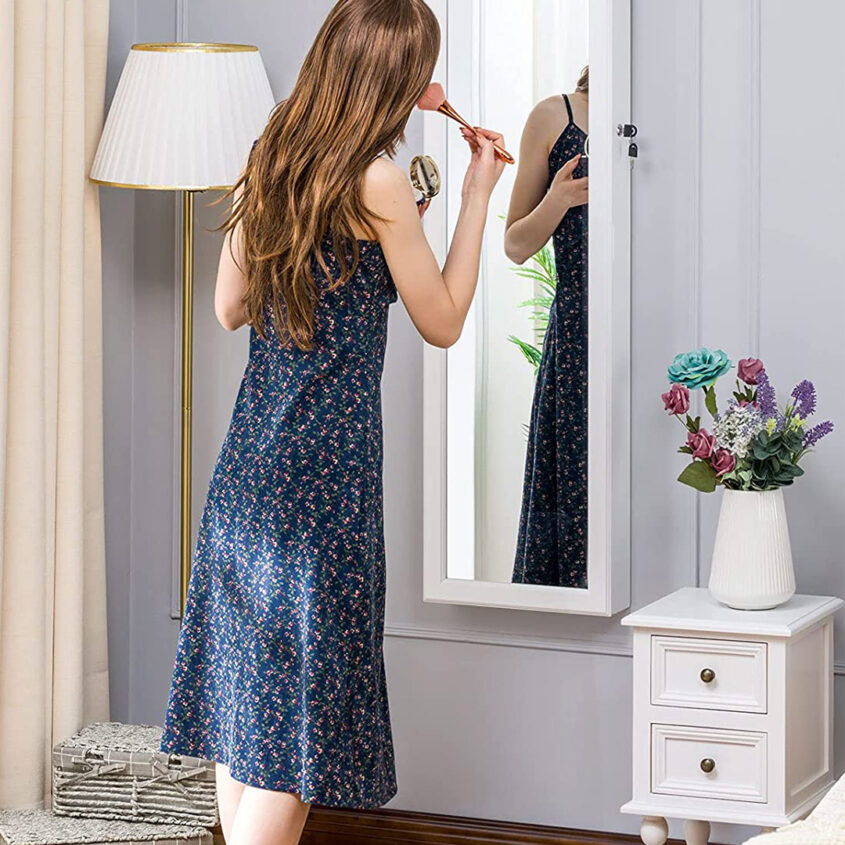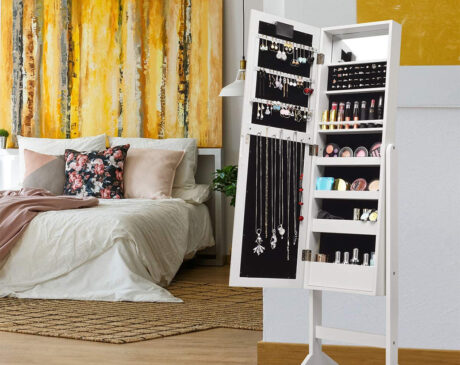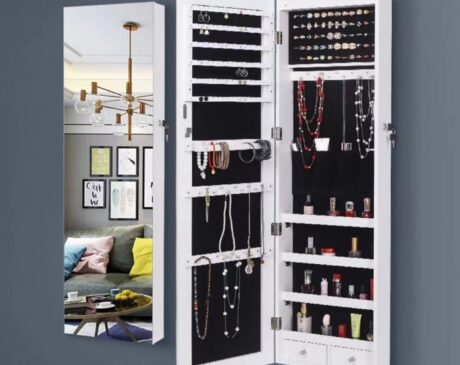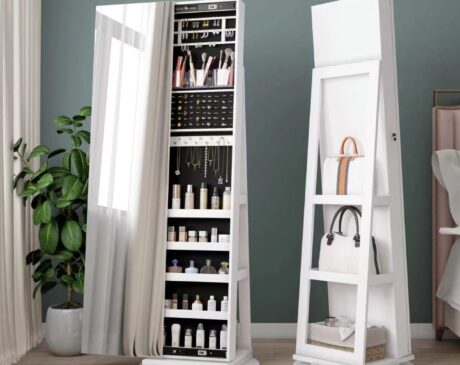How to hang jewelry armoire on wall?

In the realm of home organization and décor, the jewelry cabinet stands out for its blend of elegance and practicality. It’s more than just a box for storing knickknacks and trinkets; it’s a piece of character that requires thoughtful installation to ensure that it enhances the beauty of the room while protecting your jewelry. This comprehensive guide will walk you through the process of installing your jewelry cabinet with precision and care.
Choosing the right location
Finding the perfect location for your armoire is like choosing a frame for a painting. It must be easily accessible but out of harm’s way. Look for a location away from direct sunlight to avoid fading and damaging your jewelry. You need a location that is high enough to discourage small hands when children are present, yet easy enough for your daily use. A location close to the changing area will save you valuable time on busy mornings.
Types of Jewelry Armoires
Armoires come in a variety of shapes and sizes. Wall-mounted closets are perfect for a permanent, space-saving solution, while over-the-door closets are ideal for renters or those who like to change items frequently. The choice depends on your space, mobility needs and personal taste.
Pre-Installation Preparation
A good builder doesn’t start without tools. Gather what you need: stud finder, drill, level, screwdriver, screws, and possibly wall anchors. Clear your workspace and make sure your walls are clean and dry. If you’re working with a specific type of wall, such as drywall or plaster, make sure you have the right fixtures for that material.
Step-by-step guide to hanging a jewelry cabinet
Step 1: Find the Studs
Studs are the backbone of your walls; they hold the weight of your closet safely. A reliable stud finder can help you find them easily. If the studs are not in the correct location, you will need to use wall anchors.
Step 2: Mark the Wall
Accuracy is key. Use a pencil to mark the location of the screws. This step requires extra care – measure twice and drill once. Consider the height of the closet, the space that needs to be opened, and its position relative to other elements in the room.
Step 3: Drill pilot holes
Pilot holes guide the screws into place. Drill holes smaller than the screws to ensure a tight fit. This is the stage where mistakes can be minimized, so take your time.
Step 4: Secure the Mounting Brackets
Your closet should come with mounting brackets. This hardware is the anchor point for your furniture. Secure it firmly to the wall, making sure it’s level, before finalizing the screws.
Step 5: Attach the Armoire to the Brackets
This is a two-person job. Ask someone to help you lift the armoire and place it on the brackets. Once securely hung, perform a light tensile test to ensure it is properly fastened.
Ensure stability and security
Test the stability of the closet. If it moves, it’s not secure. Use a level to make sure it is perfectly level. If your closet feels wobbly, tighten connections or add more support with additional hardware.
Perimeter Decorating Tips
The area around your closet is like the supporting cast to the main character. The right color on the walls can make it pop, and extra lighting can make it the focal point. Be creative as well as practical – a small stool or footstool can be both an accent and a practical addition.
Maintaining Your Jewelry Armoire
Just as you love and care for your jewelry, you should love and care for its home. Use a soft microfiber cloth to avoid scratching surfaces. If your closet has glass, use an appropriate cleaner to avoid leaving streaks. Inspect hardware regularly; if it feels loose, secure it immediately to avoid accidents.
Common Challenges and Solutions
Not every wall is the same. If you’re experiencing ongoing issues, such as uneven walls, pads can be a quick fix. If you don’t have studs where you need them, wall anchors are your next best option, but make sure they are rated for the weight of your closet plus the jewelry inside.
Advanced Tips.
Make your closet work for you. Personalize the interior with extra hooks or velvet-lined compartments for delicate items. For added security, install locks or chain your closet to the wall with cable locks.
Safety Notes
Always wear protective gear when using drills and screws. For safety, do not take shortcuts. If any step in this process is beyond your comfort zone or if the closet is particularly heavy, call a professional immediately. It’s better to be safe than sorry.
The Impact of a Properly Placed Closet
A properly placed jewelry armoire can enhance the functionality of your everyday life. Not only does a well-placed closet provide easy access to your jewelry, but it also adds a touch of sophistication to your space. Take a step back and appreciate your closet as part of your room’s landscape – it should be both convenient for the individual and complementary to your home’s design.
DIY vs. professional installation
Before you begin, honestly consider your skill level. DIY can be rewarding and cost-effective, but it can also pose a risk if you’re inexperienced. Professional installation can be costly, but it can also give you peace of mind, especially with heavier components that can be dangerous if not installed correctly.
Solving Post-Installation Problems
Sometimes, even when everything looks perfect, you may notice doors that are slightly askew or drawers that are not aligned. These post-installation adjustments are normal. See your closet manual for adjustment instructions or contact the manufacturer for advice. A touch-up pen and matching paint can repair cosmetic damage, while felt pads can quiet the door.
Installing a jewelry armoire is more than a home improvement task; it’s a mission. It is a commitment to treating your jewelry with the respect it deserves. Proper installation will protect your treasures and bring an element of luxury to your space. Take the time to do it right and your jewelry cabinet will be a source of joy and functionality for years to come.
Frequently Asked Questions
Can I hang my jewelry cabinet on a wall without studs?
Yes, you can use heavy-duty wall anchors designed for the weight of your closet and jewelry. Be sure to follow the manufacturer’s instructions for the best type of anchor to use.
What is the best way to make sure my jewelry closet stays level?
Use a level when installing the brackets and the closet itself. After installation, double-check by measuring from the floor to each side of the armoire to ensure even placement.
How do I choose the right height for my closet?
Consider ergonomics. The ideal height allows you to comfortably reach all compartments without stretching or bending. A good rule of thumb is to place the center of your closet flush with your line of sight.
What maintenance does my wall-mounted jewelry armoire require?
Regular dusting and cleaning with a cleaner appropriate for the material will keep your closet looking new. Regularly check the fittings to make sure they haven’t loosened over time and tighten as needed.
What should I do if my closet swings or wobbles after installation?
This may indicate that it is not properly secured to the wall. Check all mounts and brackets, tighten any loose fittings, and make sure the closet is properly balanced on the brackets. If the problem persists, consider adding additional support or consulting a professional.




